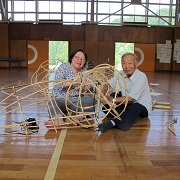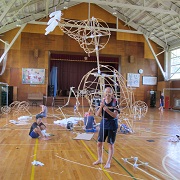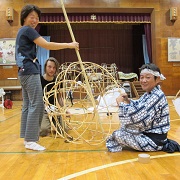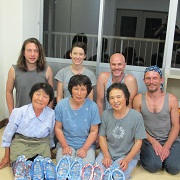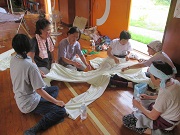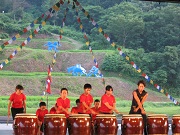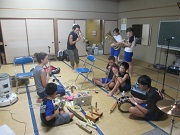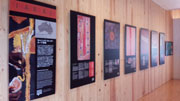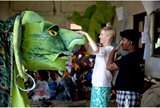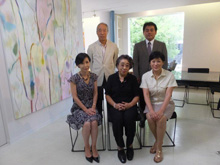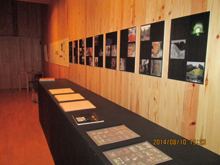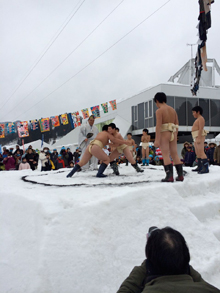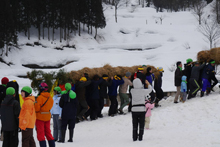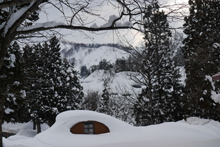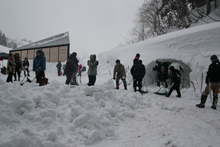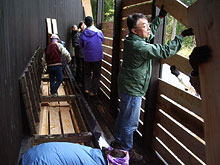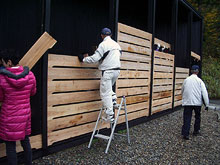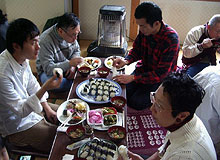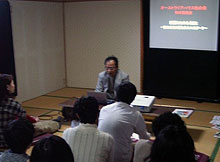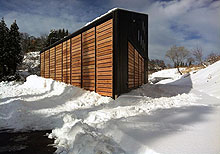Workshop at Australia House – 2000 Waraji 200 Feet
11 July 2015
12 July 2015
Australia House Residence Program Artists, Heidi Axelsen, Nathan Hawkes and Hugo Moline invite you to help create a new work for 2015 Triennale.
Workshop one:
Date: 11th July 2015
Time: 1:00pm -
Location: Australia House
Workshop two:
Date: 12th July 2015
Time: 10am-12pm, and afternoon
Location: Australia House
*Following the event on the 12th we invite all participants to join us for a BBQ at Australia House.
For more details Workshop at Australia House (PDF)
Diary: Sheah Sutton
4 June 2015
I am the Executive Producer of Snuff Puppets, a giant puppet performing arts company. We are the lucky recipients of an Asialink Residency grant to present a giant puppet spectacular, created in collaboration with the local community in Urada, to be presented as part of the Echigo-Tsumari Trienniale.
I visited the region in May to meet the producers of Echigo-Tsumari and the people of Urada to discuss the project. I had the joy of staying at Australia House for the night.
I got a chance to drive around and see the sculptural installations in the landscape. While the weather was lovely there was still snow, which I don't a chance to experience much in Australia.
Driving to Australia House, turning the corner, you see the beautiful building rising from the trees and complementing the natural environment. Inside it's just as inspiring with beautiful wooden interior.
I had such a lovely time and it was great to meet the local community as well as two other artists participating in the Trienniale. A special thanks to Yoko for welcoming me to Australia House and introducing me to the neighbours.
I can't wait to return in August!

1. Australia House

2. View from Australia House window

3. Lunch with the community
Snuff Puppets selected for Asialink performing arts residency
20 November 2014
The AJF is pleased to support the performing arts residency organised by Asialink in conjunction with Tokyo's Art Front Gallery, of the exciting Melbourne-based company - Snuff Puppets. This residency will be conducted at Australia House during the 2015 Echigo-Tsumari Triennale in Niigata. The Australia House/ETAT residency will be the first time they have returned to Japan since 2002.
Read more about the Asialink ETA residency (PDF)
Autumn Gathering in Australia House 2014
19 September 2014
Experience the beautiful sights and wonderful flavours of Echigo Tsumari, in this late Autumn home stay and sports festival weekend gathering.
Flyer (PDF)
Charity Concert: Tenor Kazuaki Osawa to sing songs from all over the world
21 August 2014
The International Culture Appreciation and Interchange Society, Inc. will host a charity concert on 10 October at Reinanzaka Church in Akasaka, Tokyo. Proceeds from the concert will be used to support young Australian artists, including those at Australia House, and the children in Fukushima. Well-known tenor, Kazuaki Osawa, will showcase his expressive voice and impressive vocal range.
Flyer (PDF)
The second Asa Matsuoka Award
18 August 2014
The second Asa Matsuoka Award was presented to the three artists participating in the Australia House Artist in Residence Program 2013-2015 by the International Culture Appreciation and Interchange Society, Inc. The Asa Matsuoka Award, named after the founder of the society, is awarded to emerging Australian artists as part of efforts to promote friendship and goodwill between Japan and countries in the Oceania region. The award, accompanied by a letter from Society President Mr George W. Gish, Jr, was presented to the NPO Echigo-Tsumari Satoyama Collective Organization by Ms Yuko Matsuoka , Executive Director and daughter of Ms Asa Matsuoka, board member Mr Shuzo Hatori and member, Professor Muneaki Samejima.
Australian books and panels on display
12 August 2014
Australian books and panels of past projects are on display at Australia House in Echigo-Tsumari until 17 August. Please come and discover the history of Australia House!
2015 Asialink Arts Residency Applications for Australia House, Echigo-Tsumari Art Triennale Now Open!
6 August 2014
Asialink Arts is calling for applications of Australian performing art groups to undertake a residency at Australia House and conduct a performance during the Echigo-Tsumari Art Triennale 2015. Applications close at 5 pm EST Tuesday 30 September 2014. For more information please refer to: Asialink's website
Diary
6 March 2014
The snow sports day was such a full day it is difficult to write about it briefly. Young sumo wrestlers braved the icy day to compete, traditional bound rice straw towers were carried by each team and then set alight, everyone danced the kanjiki dance, traditional echigo noragi and tattsuke farming clothes were strung like flags above the sports arena,
It was inspiring to be part of an event where a genuine respect for tradition combined so comfortably with fun, hilarious and hectic team events. The food was also delicious!
Diary
24 February 2014
We have arrived back in Urada and the snow is amazing! We were welcomed very warmly by the people of Urada with an amazing welcome dinner party. It was so good to see our old friends again and the meal was so delicious!
The next day we held a workshop at Australia House. The young people of Urada helped us prepare four snow caves which we combined with eucalypt leaves from the Australian summer we just left to create small sensory installations.
Afterwards everyone helped to build a huge snow-hut with candles. We had a fire and the local ladies prepared a delicious stew. Maruyama-san and the Mayor of Tokamachi both spoke and the Jørn Utzon International Architecture Prize was awarded to Australia House.
A local band called ‘kiori-oktai’ (collaboration) played some very beautiful songs by Hibari Misora and the kids took turns sliding down the hill behind the house on tabogans. It was a great day that everyone helped to make together.
Event Information
23 February 2014
Australia House – Snow art workshop and winter gathering
The three Australian artists, Hugo, Heidi and Nathan are back and will start their two-week winter residency at Australia House on 22 February 2014. Through their residency they will again conduct research for their Echigo-Tsumari Art Triennale 2015 project, and will work and collaborate with the local community. Their first workshop will be held right after they arrive, with the Urada Community youth organization.
Details
Date/Time: 1pm-6pm Sunday 23 February, 2014
13:00 Snow Art Workshop: (The artists will conduct a workshop to create art using the snow around Australia House)
15:00 Winter Gathering: (refreshments and music performances): Australian style cheese steak and mulled wine will be served. Women from the local community will also prepare hot tonjiru soup and onigiri rice balls. Two local bands will perform.
Fees: Workshop : free
Gathering: 1,000yen
Transportation to Australia House (shuttle bus)
12:30 Depart Matsudai station for Australia House
15:00 Depart Australia House for Matsudai Station
18:00 Depart Australia House for Matsudai Station
Bookings: Echigo Tsumari Art Field Information Centre
Tel: 025-761-7767 Fax: 025-761-7911
info@tsumari-artfield.co
News
14 November 2013
The Autumn Gathering at Australia House was held on 10 November. The snow fences were put up in about an hour thanks to the speedy efforts of everyone involved. Participants enjoyed a delicious autumn lunch with onigiri rice balls made from newly-harvested local rice, accompanied by mushroom and vegetable soup. Lunch was followed by a seminar about Aboriginal art by Fram Kitagawa.
Aboriginal art expresses creation myths known as the "Dreamtime" and, according to Mr Kitagawa, Aboriginal people - and all human beings - have the memory of their ancestors in their DNA and we are able to see them in our dreams. Everyone enjoyed a fascinating conversation about dreams.
Despite the occasionally heavy wind and rain, everyone had a pleasant time learning about people down under and thinking about the history of mankind and the world of dreams as they prepared for the winter in Urada - located in the Echigo Tsumari region. Apparently, it snowed the next day so Australia House will be covered in snow for the next few months at least.
Event Information
10 November 2013
Autumn Gathering at Australia House
Snow Fences, Onigiri Lunch and Autumn Seminar

Australia House
Autumn has come to Australia House in Urada and we are holding a gathering to celebrate! The Tsumari region is known for its heavy snowfalls and autumn is the perfect time to prepare for the cold winter ahead. Our speaker, Mr Tetsuro Iizuka, will give participants a brief explanation about snow fences and the community’s preparations for winter before demonstrating the installation of a snow fence at Australia House.
This will be followed by a lunch featuring delicious onigiri rice balls made with newly-harvested local rice and mushroom and vegetable soup made by members of the community's Wome's Association. A seminar will be held in the afternoon – the latest in a series of talks about Australia for the local community. This time, Fram Kitagawa will speak about Aboriginal art. The seminar is open to everyone.
This event will be a wonderful opportunity for both Australians and Japanese to meet and interact at Australia House. We look forward to seeing you there!
Date/Time: 10:30 am Sunday, 10 November 2013
10:30 Snow fence talk and demonstration
12:30 Onigiri Lunch
13:30 Autumn Seminar (talk will conclude at 15:30)
Venue: Australia House (7577 Urada, Tokamachi City)
* Lunch and the seminar will be held at the Nakatateyama Community Centre (7575 Urada, Tokamachi City)
Details:
- Snow Fence Talk and Demonstration
Speaker: Tetsuro Iizuka (Urada)
Title: Snow Fences and Winter Preparations in the Tsumari Region
Mr Iizuka will demonstrate the installation of a snow fence at Australia House after the talk.
- Onigiri Lunch
Participants can enjoy delicious seasonal dishes including rice balls made with newly-harvested rice, mushroom and vegetable soup and pickles.
- Autumn Seminar at Australia House
Speaker: Fram Kitagawa
Title: Aboriginal Art – Art from the Dreamtime and the Outback
- Participants are welcome to participate in either the whole program or each individual session.
- Those wishing to participate in the snow fence demonstration should wear comfortable clothes and shoes suitable for outdoor work. (If possible, please bring your own gunte work gloves.)
Fees: Onigiri Lunch – 500 yen
Autumn Seminar: 500 yen (free for primary and junior high school students)
Bookings: Echigo Tsumari Art Field Information Centre
Tel: 025-761-7767 Fax: 025-761-7911
e-mail:info@tsumari-artfield.com
Please reserve your place by Friday, 1 November
Please provide your name, contact details (phone number, e-mail address, etc), specify which sessions you wish to participate in (snow fence talk, lunch, seminar) and whether you wish to use the shuttle bus service. Bookings can be made by e-mail, fax or telephone.
* Shuttle Bus available between Tokamachi/Matsudai Stations and Australia House
(Tokamachi Station – Australia House: 500 yen)
(Matsudai Station – Australia House: 300 yen)
Australia House Shuttle Bus Timetable for Sunday, 10 November
To Australia House
Tokamachi Station (9:45) → Matsudai Station (10:10) → Australia House (10:30)
From Australia House
Australia House (15:35) → Matsudai Station (15:55) → Tokamachi Station (16:20)
Bus departure times are timed to connect with the Hakutaka Express train's arrival at/departure from Tokamachi Station. The Hakutaka Express connects with the Joetsu Shinkansen at Echigo-Yuzawa Station. Arrival at Tokamachi Station: 9:42, Departure: 16:30
|
Diary
31 August 2013
Heidi Axelsen
Dancing, forging and weaving
In preparation for our final week in Urada, we offered to accompany local people in their daily lives and to help with odd jobs. As it turned out people were quite happy to do their own odd jobs and we found ourselves being fed delicious delicacies instead!
Izuka-san and his grandson Koya-kun acompanied us to all the visits to introduce us & help us with interpreting. Koya-kun is 10 years old and was a great teacher for us in both Japanese and magic tricks! At Yuji-san’s house in the hills behind the village of Urada, he and his wife invited us their 200 year old house. Yuji-san showed us by drawing the way his house was originally built with giant river stones foundation pillars and treated us to many delicious home-made pickles and seaweed.
Sato-san and his wife live further up the valley quite close the Australia House where he showed us his small factory which houses his machine for drying rice and storing potatoes. He also took us on an adventure into the nearby bush to dig out some clay. Nothing seems to tire these strong people, he whipper-snipped a 100m path through thick bush for us to find the clay at the base of a large tree. We now have a bucket full of earth to return to in the winter!
The last visit we had was to Gombei-san's house who is the closest neighbour to Australia House. After a karoke concert in Gomberi-san's lounge room, he taught us to make hand weave straw sandals called 'warazi'.
Looking back at our time here the most precious experiences have been the opportunity to engage physically in the act of making. Doing and learning a choreography of movements, refined with practice and repetition, such as weaving slippers from rice straw, forging slender nails from metal rods, dancing at Obon. Creating by watching, imitating, making mistakes, perfecting and reaching an end to begin again.
On Saturday morning we joined the weekly gathering of local old ladies down at Izuka San's supermarket. With Daisuke's help we chatting with them about the old days over pickles and tea before dropping them all home on the mini bus. They told us about the past in this region, the hardship but also the closeness of people. It was a very special experience for all of us. One lady, more than 80 years old told us we were the first foreigners she had ever met.
In the final workshop we held at Australia House, we were interested in uncovering peoples sensory seasonal memories of Satoyama. We prepared a series of timber rods in three different length with a series of notches. On each face of a timber rod we asked people to write their sense memory, taste/smell, touch and sound of satoyama and then on the last face to write their hope for satoyama. Each person then painted their timber rod and set about to make a structure together, finding a place for their contribution to fit in a whole. The result was a collective spindly and intricate structure held together by strings and notches.
On our last days in Urada we visited several 'akiya', abandoned traditional farm house many of which are beautifully constructed with woven cedar rafters, yet are now shells with traces of the families that were there. We have been told de-population is a result of the rapid industrialisation in Japan and the decline in agriculture, though it is shocking to experience a place as beautiful as this being abandoned.
Living so close to a land with 40 degree days in summer and 4 meters of snow in winter, is a tough environment for anyone especially the elderly. Yet they are the most vital old people I have ever met. There are so few young people here, as they seem to be daunted by the isolation and the 'inconvenience' of country life,and of course the lack of work.
We have been told many times about the depth of the snow and can only imagine the weight and pressure this puts on the peoples lives and the physical infrastructure. We will get to experience when we return in winter next year for massive snowfall!
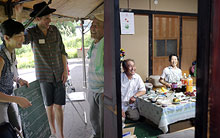
1. Chalk board calendar and Sato-san's lounge room. Photo by Heidi Axelsen
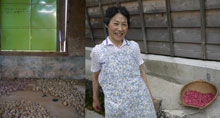
2. Sato-san's azuki beans and potatoes. Photo by Heidi Axelsen

3. Yugi-san's drawing and stone pillars. Photo by Nathan Hawkes
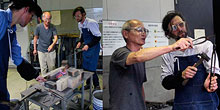
4. Master and apprentices: Hugo and Nathan forging nails. Photos by Heidi Axelsen

5. Weaving straw sandals with Gombei-san, one by master one by Heidi the 'apprentice'. Photo by Hugo Moline.

6. Morning tea and supermarket deliveries. Photos by Heidi Axelsen

7. Writing satoyama sensory memories & hopes. Photo by Nathan Hawkes
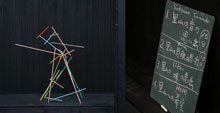
8. Satoyama sensory memories & hopes. Photo by Nathan Hawkes
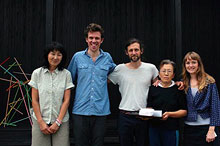
9. Final day in Urada
Diary
23 August 2013
Hugo Moline
Stages of becoming a kettle
After my restful week of quarantine, Australia House feels now like a kind of ship I have taken a long voyage in.
Since disembarking we have spent the week days getting to know the amazing people, places and art of Echigo Tsumari.
We had a great afternoon tea with locals coming from Urada, Joetsu and Niigata City. The local ladies cooked up an incredible feast of local delacacies including pickled baby fern, seaweed jelly noodles and red basil cordial. Oishi nee!
We made pikelets with jam, not quite equal to our hosts' offering, but enjoyed by the kids!
Further afield Yoko-san organised a great visit to the industrial riverside city of Sanjo. There we were taught how to forge Japanese nails and saw how a single circle of copper can slowly be beaten into a full kettle.
We also met a man who runs an agricultural tool making factory. There are more than 10,000 types of hoe in Japan, varying by locality, terrain and soil type. Old farmers bring in their old hoes for repair and replication, adding to the factory's knowledge bank of hoe typologies.
In many of the towns of the artfield the schools have been closed down due to depopulation. Christian Boltanski's haunting The Last Class and the Hachi community with Seizo Tashima's wonderful Walk-In Picture Book both had very deep impression on us.
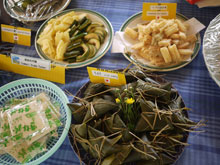
Local delicacies

Stages of becoming a kettle

The first stage of making one of 10,000 different hoes
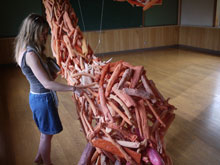
Seizo Tashima's
Walk-In Picture Book
News
20 August 2013
On 18 August, the event "Come have tea with us! - Aussie Afternoon Tea vs. Typical Tsumari Tucker" was held at Australia House. Members and children of the Urada community, members of the Japan-Australia Society of Joetsu, the Niigata-Australia Association, and Ms Dara Williams, Minister-Counsellor of the Australian Embassy, participated in the event. Participants enjoyed the interactive event tasting Australian snacks prepared by Hugo, Heidi and Nathan and the homemade sticky-rice and pickled vegetables prepared by the Urada Community Ladies.
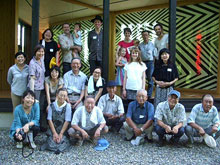
Group Photo of Participants
Diary
15 August 2013
Nathan Hawkes
unfolding the map
Having to remain here at Australia house the last 4 or 5 days has really helped us tune into the sensory aspects of nature here in the summer time. The insects whir and shimmer all around, and approach an almost deafening frenzy when you walk a little deeper into the forest. There is a kind of architecture to this sound, like thousands of cells vibrating, creating an audible structure. The cicada's and crickets are the most obvious but their endless sound is punctuated by the sudden loud calls of other insects. It reminds me quite a bit of the Australian bush in the summer - soaked in an extremely humid heat. The other benefit for us of Hugo's flu is we can work downstairs while Australia house is closed, and the view down here is a feast for the eyes, and it is wonderfully framed by the black pillars of Andrew Burns' architecture.
We were given a wonderful tour of traditional architecture today by Iizuka-san who owns a local construction company. This involved a visit to Gombe-san's 160 year house close to Australia House - what a treat to sit inside his and his wife, Sumie-san's beautiful home and have him sing for us - this man has an awesome voice! - he showed us up inside the roof of his house to see the way a traditional rice-straw thatch roof is constructed, and as we were leaving we were given a pair of rice straw thongs each made by Sumie-san - a perfect day!
Hugo has been asked to rest here a few more days, but Heidi and I have just begun to drive around and visit some of the works that are part of the Echigo-Tsumari Art Field and feel completely blown away by the quality of what we have seen, the way the works engage so deeply with the local area.
In following the map of artworks one traces the landscape of this unique place, its people and their traditions; the way the works are located all over this region encourage you to fully engage with the space between them.
Needless to say, the opportunity to follow the trail around the Echigo-Tsumari Art Field is reason alone to visit Japan, but the chance to contribute is extremely exciting. Now we just can't wait to begin learning from and collaborating with the local people!

Gombe-san singing for us
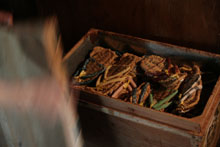
wooden box full of Sumie-san's hand made rice straw slippers
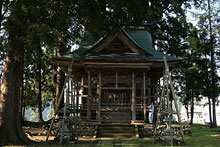
Shinto Shrine in Urada
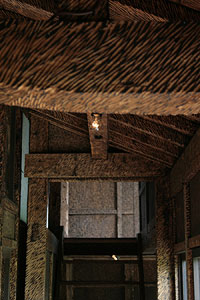
Inside the Shedding House - one of the many awesome works of the Echigo Tsumari Art Field

the view from inside the workspace
News
12 August 2013
Temporary closure of Australia House (10 – 16 August) and change in Event Schedule
Australia House will be temporarily closed from 10 to 16 August.
The event "Come have tea with us! Aussie Afternoon Tea vs. Typical Tsumari Tucker", originally scheduled for 11 August, will now take place on 18 August. The "Get Creative at Australia House!" workshop scheduled for 18 and 25 August will now take place on 25 August only.
We thank you for your kind understanding.
Diary
10 August 2013
Heidi Axelsen
Breakfast satoyama - half rice, half toast
This is now our third day waking up to the sounds of cicadas and many other buzzing bugs here at Australia House. Through the night there is a beautiful soft breeze that give sweet relief to the hotness of the days, it reached 36 degrees yesterday!
It has been rich and a bit of a bumpy start to our residency here. Coming from Sydney's winter Hugo carried with him an Australian flu that he is now riding through in a humid Japanese summer – poor thing!
We have been requested not to leave the house and to wear white Japanese masks until Hugo fully recovers in fear for passing on the flu to the locals! So we are now all in house arrest here at the beautiful Australia House in the hills of Urada, near Matsudai which is actually a marvellous place to be stuck! It is actually a relief that we have been forced to slow down and simplify our days as there is so much to absorb already. We were moving at quite a rapid pace in Tokyo and then to Tokamachi meeting so many wonderful and important people and taking in a whirlwind of newness.
We are blessed with the generosity of our hosts and local volunteers who tirelessly assist us with any need. Daisuke has also been a wonderful help translating for us and accompanying us to both the City Mayors office and the hospital! Yoko San is a local school art teacher from Niigata City who has volunteers her weekends to generously show us where we can buy this or that, how to navigate hardware stores and find other local treasures. She also has leant us a whole lot of interesting books about Japanese art and supplied us with art materials.
We are starting to grasp the scope of the word 'satoyama'. Coming from the characters for ‘cultivated field’ and 'mountain', it not only describes this place where human settlement meets the woods, it talks about how nature and humanity connect and co-exist across time and place.
Some of the local delights we have already been fortunate to sample is the delicious carrot juice which is more like a sweet nectar. The carrots become sweet and dense in the winter months while buried under snow. I have also been enjoying the local grown mild filter coffee infused with local chrysanthemum and the calm & steady energy it gives to work through the heat.
The attention to detail and precision in everything is astounding, from the traffic man in his LED flashing high-vis vest, elegantly waving red and white flags to the mosaic pattern of rice paddies terraced on the hills. We are also very excited by the local industries we are finding, there appears to be stone masons working with granite, paper making, specialist tool manufactures near by in Joetsu and large concreting companies and we are yet to find the wood workers.
This is beginning of a large and long-term project and we feel really very lucky to be having this experience and now we can't wait to really get started.
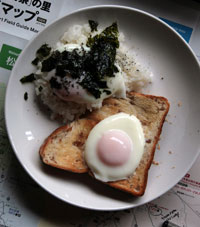
Heidi's transitional breakfast: eggs on toast or eggs on rice or both!
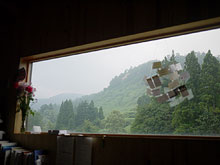
View from the upstairs window at Australia House including a mobile of all the business cards we have been given, a reminder of all the people we have met.

Seeing the rice in it's husks getting ready for harvest
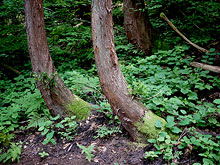
Japanese cedar trees bent by the weight of the snow
News
7 August 2013
Artists arrive for the Australia House Artist in Residence Program 2013-2015
Sydney-based artists Heidi Axelsen, Hugo Moline and Nathan Hawkes arrived in Japan today to participate in the Australia House Artist-in-Residence Program 2013-2015. The artists will stay in Echigo Tsumari on a number of occasions, starting this summer, with the ultimate goal of exhibiting their artworks at the 2015 Echigo-Tsumari Art Triennale. They will be staying at Australia House for around 20 days this time. Before departing for Echigo Tsumari, they met with General Director of Echigo-Tsumari Art Triennale Mr Fram Kitagawa and his colleagues, as well as staff from the Australian Embassy in Tokyo. The artists expressed their excitement about their participation in the program.
On the same day, the International Culture Appreciation and Interchange Society, Inc. presented the inaugural Asa Matsuoka Award to the artists. The Asa Matsuoka Award, named after the founder of the society, is awarded to artists - such as those who come to live and work at Australia House- as part of efforts to promote friendship and goodwill between Japan and countries in the Oceania region. The award was presented by Ms Yuko Matsuoka , Executive Director and daughter of Ms Asa Matsuoka, and board member Professor Muneaki Samejima.
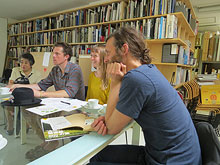
Meeting with Embassy staff

Award Ceremony
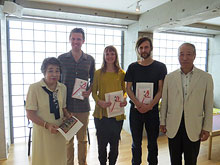
(From left) Ms Matsuoka, Hugo, Heidi, Nathan, Professor Samejima
Asa Matsuoka Award Press Release from the International Culture Appreciation and Interchange Society (PDF)
Event Information
6 August 2013
Get creative at Australia House!
Experience the creative process at Australia House
What can you make in Urada? Participants in this Workshop will be able to interact with the Australian artists-in-residence and experience the creative process first-hand. Everyone is welcome!
Date / Time Sunday 25 August, 13:30 – 15:00
Venue: Australia House Terrace
Charge: Free (Participants need to pay the Australia House admission fee)
Event Information
6 August 2013
Come have tea with us! - Aussie Afternoon Tea vs. Typical Tsumari Tucker –
Visitors to Australia House will be treated to some Australian and Japanese snacks and refreshments. Join us for afternoon tea - eat, drink and have some fun!
Come and meet the Australian artists-in-residence for a fun interactive Aussie afternoon in Urada. Everyone is welcome!
Date / Time Sunday 18 August, 13:30 – 15:00
Venue: Area in front of the Australia House Terrace
Charge: Free (Participants need to pay the Australia House admission fee)
News
2 July 2013
Australia House Artists-in-Residence Selected
Read more
News
2 May 2013
Echigo-Tsumari Artist-in-Residence Program 2013-2015
Read more
Archives
News & Diary - Archives
Read more
The views expressed by any contributors to this site are those of the individual contributor.


